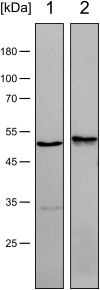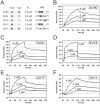Contribution of plasminogen activation towards the pathogenic potential of oral streptococci
- PMID: 21072208
- PMCID: PMC2972214
- DOI: 10.1371/journal.pone.0013826
Contribution of plasminogen activation towards the pathogenic potential of oral streptococci
Abstract
Oral streptococci are a heterogeneous group of human commensals, with a potential to cause serious infections. Activation of plasminogen has been shown to increase the virulence of typical human pathogenic streptococci such as S. pneumoniae. One important factor for plasminogen activation is the streptococcal α-enolase. Here we report that plasminogen activation is also common in oral streptococci species involved in clinical infection and that it depends on the action of human plasminogen activators. The ability to activate plasminogen did not require full conservation of the internal plasminogen binding sequence motif FYDKERKVY of α-enolase that was previously described as crucial for increased plasminogen binding, activation and virulence. Instead, experiments with recombinant α-enolase variants indicate that the naturally occurring variations do not impair plasminogen binding. In spite of these variations in the internal plasminogen binding motif oral streptococci showed similar activation of plasminogen. We conclude that the pathomechanism of plasminogen activation is conserved in oral streptococci that cause infections in human. This may contribute to their opportunistic pathogenic character that is unfurled in certain niches.
Conflict of interest statement
Figures






Similar articles
-
Antibiotic modulation of the plasminogen binding ability of viridans group streptococci.Antimicrob Agents Chemother. 2012 Jan;56(1):458-63. doi: 10.1128/AAC.00452-11. Epub 2011 Oct 28. Antimicrob Agents Chemother. 2012. PMID: 22037854 Free PMC article.
-
Identification of a novel plasmin(ogen)-binding motif in surface displayed alpha-enolase of Streptococcus pneumoniae.Mol Microbiol. 2003 Jul;49(2):411-23. doi: 10.1046/j.1365-2958.2003.03557.x. Mol Microbiol. 2003. PMID: 12828639
-
Streptokinase activates plasminogen bound to human group C and G streptococci through M-like proteins.Eur J Biochem. 1994 Jun 1;222(2):267-76. doi: 10.1111/j.1432-1033.1994.tb18865.x. Eur J Biochem. 1994. PMID: 8020466
-
Putative pathogenic factors underlying Streptococcus oralis opportunistic infections.J Microbiol Immunol Infect. 2025 Apr;58(2):157-163. doi: 10.1016/j.jmii.2024.09.001. Epub 2024 Sep 6. J Microbiol Immunol Infect. 2025. PMID: 39261123 Review.
-
How to become a killer, or is it all accidental? Virulence strategies in oral streptococci.Mol Oral Microbiol. 2018 Feb;33(1):1-12. doi: 10.1111/omi.12192. Epub 2017 Aug 24. Mol Oral Microbiol. 2018. PMID: 28727895 Review.
Cited by
-
Enolase of Staphylococcus lugdunensis Is a Surface-Exposed Moonlighting Protein That Binds to Extracellular Matrix and the Plasminogen/Plasmin System.Front Microbiol. 2022 Mar 3;13:837297. doi: 10.3389/fmicb.2022.837297. eCollection 2022. Front Microbiol. 2022. PMID: 35308335 Free PMC article.
-
Potential of known and short prokaryotic protein motifs as a basis for novel peptide-based antibacterial therapeutics: a computational survey.Front Microbiol. 2014 Jan 21;5:4. doi: 10.3389/fmicb.2014.00004. eCollection 2014. Front Microbiol. 2014. PMID: 24478765 Free PMC article.
-
Dancing to another tune-adhesive moonlighting proteins in bacteria.Biology (Basel). 2014 Mar 10;3(1):178-204. doi: 10.3390/biology3010178. Biology (Basel). 2014. PMID: 24833341 Free PMC article.
-
The interaction of canine plasminogen with Streptococcus pyogenes enolase: they bind to one another but what is the nature of the structures involved?PLoS One. 2011;6(12):e28481. doi: 10.1371/journal.pone.0028481. Epub 2011 Dec 9. PLoS One. 2011. PMID: 22174817 Free PMC article.
-
Role of extracellular transaldolase from Bifidobacterium bifidum in mucin adhesion and aggregation.Appl Environ Microbiol. 2012 Jun;78(11):3992-8. doi: 10.1128/AEM.08024-11. Epub 2012 Mar 23. Appl Environ Microbiol. 2012. PMID: 22447584 Free PMC article.
References
-
- Claridge JE, 3rd, Attorri S, Musher DM, Hebert J, Dunbar S. Streptococcus intermedius, Streptococcus constellatus, and Streptococcus anginosus (“Streptococcus milleri group”) are of different clinical importance and are not equally associated with abscess. Clin Infect Dis. 2001;32:1511–1515. - PubMed
-
- Jacobs JA, Pietersen HG, Stobberingh EE, Soeters PB. Bacteremia involving the “Streptococcus milleri” group: analysis of 19 cases. Clin Infect Dis. 1994;19:704–713. - PubMed
-
- Colombo AP, Haffajee AD, Dewhirst FE, Paster BJ, Smith CM, et al. Clinical and microbiological features of refractory periodontitis subjects. J Clin Periodontol. 1998;25:169–180. - PubMed
Publication types
MeSH terms
Substances
LinkOut - more resources
Full Text Sources
Other Literature Sources
Miscellaneous

